Quality Management Plan for Perth War Cemetery Resurfacing Project
VerifiedAdded on 2020/03/15
|21
|6368
|53
Project
AI Summary
This document presents a comprehensive Quality Management Plan (QMP) for the Perth War Cemetery Resurfacing Project, undertaken by Porter Consulting Engineers (PCE). The QMP outlines the project's quality definition, assumptions, constraints, responsibilities, organization, and interfaces. It details the tools and environment, including specific tests for asphalt and materials, referencing relevant standards like Austroads. The plan covers quality planning, control, and assurance processes, aligned with ISO 9001 standards. It describes the roles of key personnel, quality metrics, and non-conforming item management. The QMP ensures the project meets design requirements, government regulations, and client expectations, emphasizing continuous improvement and defect prevention. It includes various documents like a Quality Manual and Policy to achieve quality objectives. The project aims to deliver a high-quality resurfacing project, meeting the required standards.
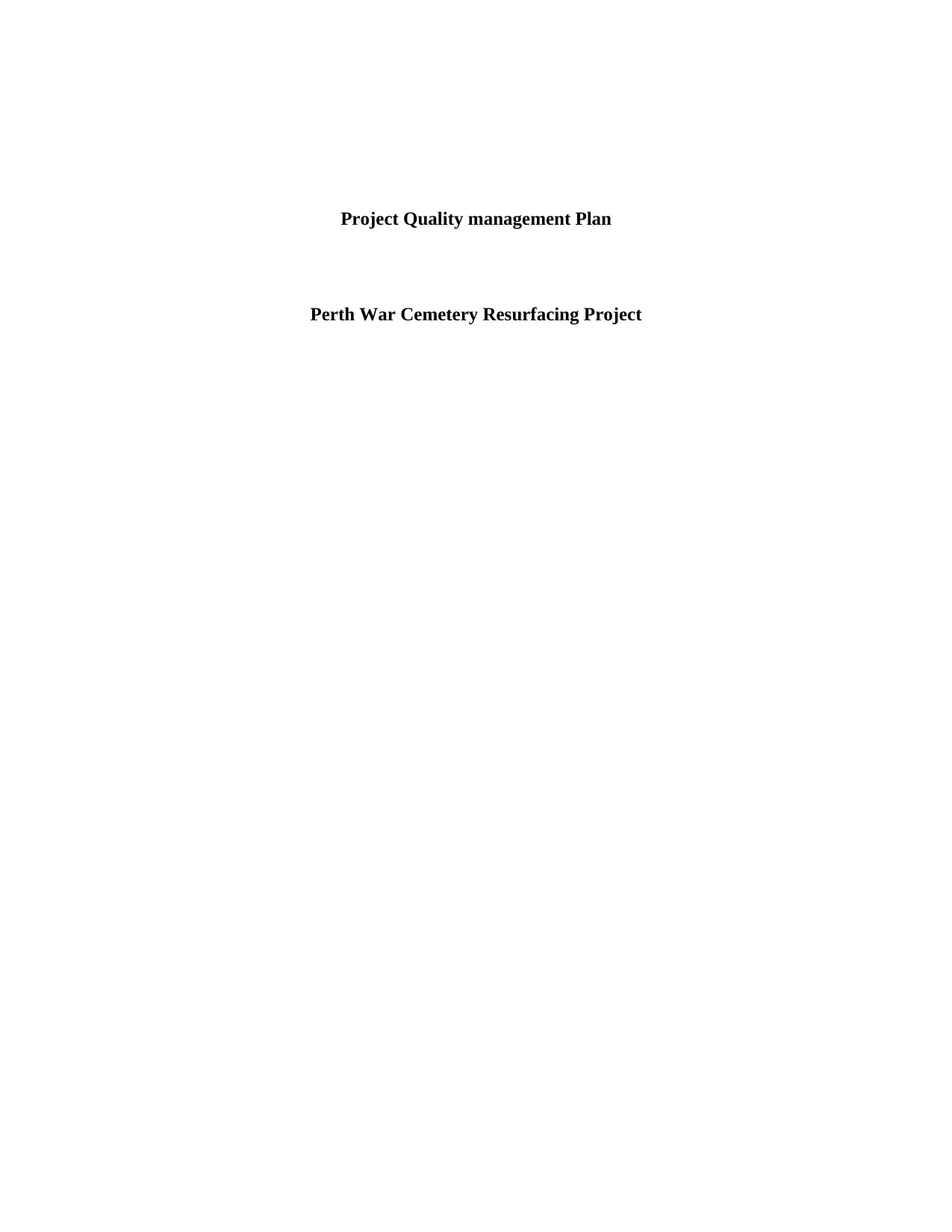
Project Quality management Plan
Perth War Cemetery Resurfacing Project
Perth War Cemetery Resurfacing Project
Paraphrase This Document
Need a fresh take? Get an instant paraphrase of this document with our AI Paraphraser
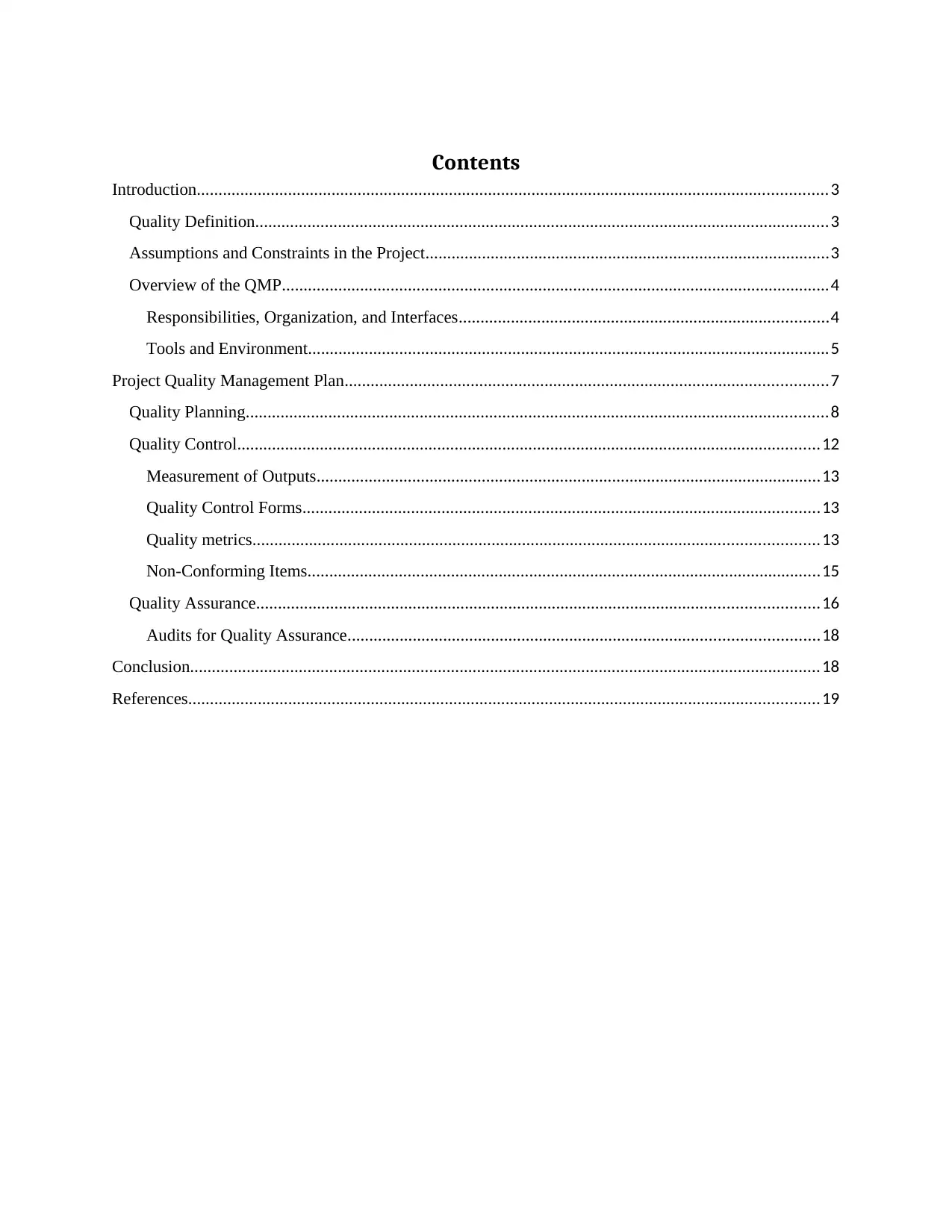
Contents
Introduction.................................................................................................................................................3
Quality Definition....................................................................................................................................3
Assumptions and Constraints in the Project.............................................................................................3
Overview of the QMP..............................................................................................................................4
Responsibilities, Organization, and Interfaces.....................................................................................4
Tools and Environment........................................................................................................................5
Project Quality Management Plan...............................................................................................................7
Quality Planning......................................................................................................................................8
Quality Control......................................................................................................................................12
Measurement of Outputs....................................................................................................................13
Quality Control Forms.......................................................................................................................13
Quality metrics..................................................................................................................................13
Non-Conforming Items......................................................................................................................15
Quality Assurance.................................................................................................................................16
Audits for Quality Assurance............................................................................................................18
Conclusion.................................................................................................................................................18
References.................................................................................................................................................19
Introduction.................................................................................................................................................3
Quality Definition....................................................................................................................................3
Assumptions and Constraints in the Project.............................................................................................3
Overview of the QMP..............................................................................................................................4
Responsibilities, Organization, and Interfaces.....................................................................................4
Tools and Environment........................................................................................................................5
Project Quality Management Plan...............................................................................................................7
Quality Planning......................................................................................................................................8
Quality Control......................................................................................................................................12
Measurement of Outputs....................................................................................................................13
Quality Control Forms.......................................................................................................................13
Quality metrics..................................................................................................................................13
Non-Conforming Items......................................................................................................................15
Quality Assurance.................................................................................................................................16
Audits for Quality Assurance............................................................................................................18
Conclusion.................................................................................................................................................18
References.................................................................................................................................................19
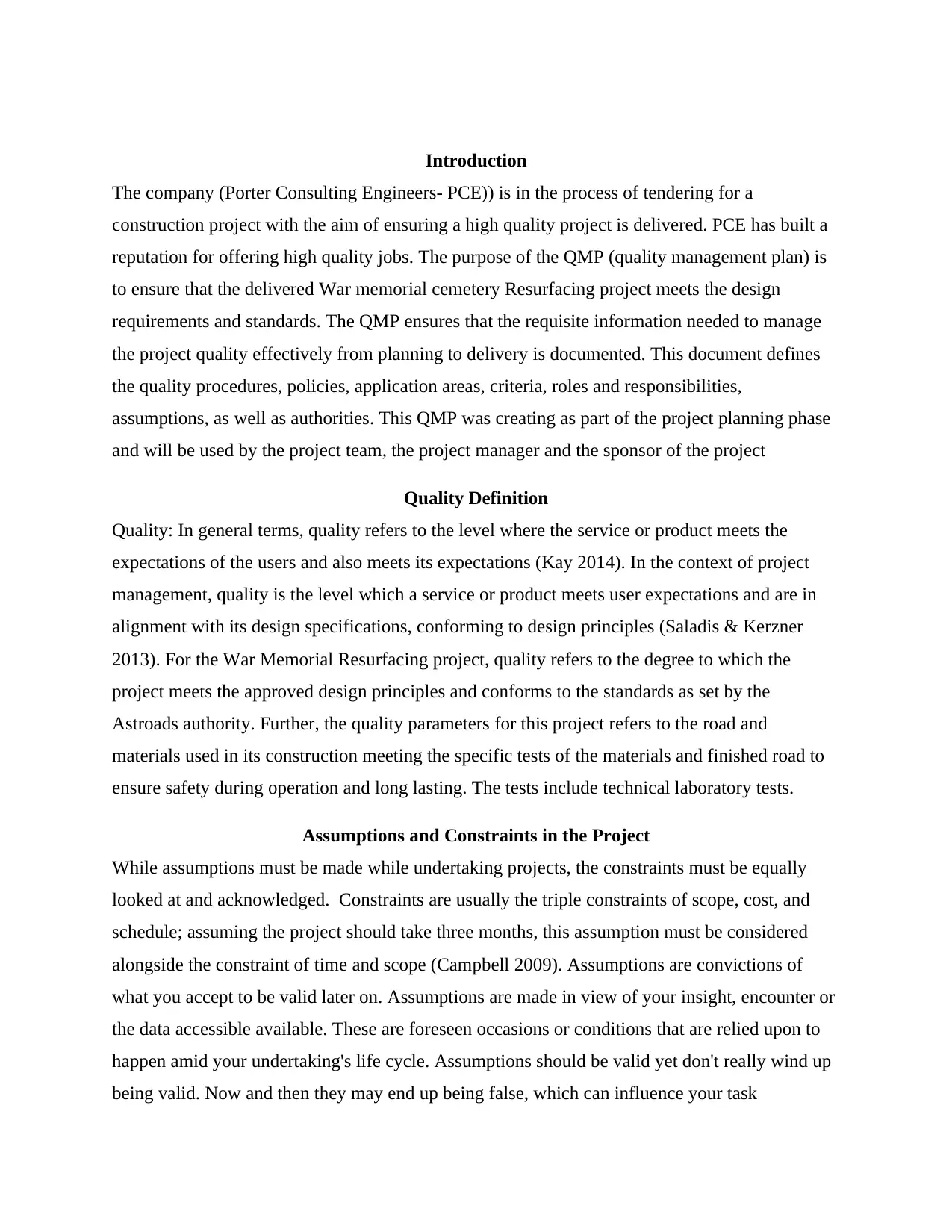
Introduction
The company (Porter Consulting Engineers- PCE)) is in the process of tendering for a
construction project with the aim of ensuring a high quality project is delivered. PCE has built a
reputation for offering high quality jobs. The purpose of the QMP (quality management plan) is
to ensure that the delivered War memorial cemetery Resurfacing project meets the design
requirements and standards. The QMP ensures that the requisite information needed to manage
the project quality effectively from planning to delivery is documented. This document defines
the quality procedures, policies, application areas, criteria, roles and responsibilities,
assumptions, as well as authorities. This QMP was creating as part of the project planning phase
and will be used by the project team, the project manager and the sponsor of the project
Quality Definition
Quality: In general terms, quality refers to the level where the service or product meets the
expectations of the users and also meets its expectations (Kay 2014). In the context of project
management, quality is the level which a service or product meets user expectations and are in
alignment with its design specifications, conforming to design principles (Saladis & Kerzner
2013). For the War Memorial Resurfacing project, quality refers to the degree to which the
project meets the approved design principles and conforms to the standards as set by the
Astroads authority. Further, the quality parameters for this project refers to the road and
materials used in its construction meeting the specific tests of the materials and finished road to
ensure safety during operation and long lasting. The tests include technical laboratory tests.
Assumptions and Constraints in the Project
While assumptions must be made while undertaking projects, the constraints must be equally
looked at and acknowledged. Constraints are usually the triple constraints of scope, cost, and
schedule; assuming the project should take three months, this assumption must be considered
alongside the constraint of time and scope (Campbell 2009). Assumptions are convictions of
what you accept to be valid later on. Assumptions are made in view of your insight, encounter or
the data accessible available. These are foreseen occasions or conditions that are relied upon to
happen amid your undertaking's life cycle. Assumptions should be valid yet don't really wind up
being valid. Now and then they may end up being false, which can influence your task
The company (Porter Consulting Engineers- PCE)) is in the process of tendering for a
construction project with the aim of ensuring a high quality project is delivered. PCE has built a
reputation for offering high quality jobs. The purpose of the QMP (quality management plan) is
to ensure that the delivered War memorial cemetery Resurfacing project meets the design
requirements and standards. The QMP ensures that the requisite information needed to manage
the project quality effectively from planning to delivery is documented. This document defines
the quality procedures, policies, application areas, criteria, roles and responsibilities,
assumptions, as well as authorities. This QMP was creating as part of the project planning phase
and will be used by the project team, the project manager and the sponsor of the project
Quality Definition
Quality: In general terms, quality refers to the level where the service or product meets the
expectations of the users and also meets its expectations (Kay 2014). In the context of project
management, quality is the level which a service or product meets user expectations and are in
alignment with its design specifications, conforming to design principles (Saladis & Kerzner
2013). For the War Memorial Resurfacing project, quality refers to the degree to which the
project meets the approved design principles and conforms to the standards as set by the
Astroads authority. Further, the quality parameters for this project refers to the road and
materials used in its construction meeting the specific tests of the materials and finished road to
ensure safety during operation and long lasting. The tests include technical laboratory tests.
Assumptions and Constraints in the Project
While assumptions must be made while undertaking projects, the constraints must be equally
looked at and acknowledged. Constraints are usually the triple constraints of scope, cost, and
schedule; assuming the project should take three months, this assumption must be considered
alongside the constraint of time and scope (Campbell 2009). Assumptions are convictions of
what you accept to be valid later on. Assumptions are made in view of your insight, encounter or
the data accessible available. These are foreseen occasions or conditions that are relied upon to
happen amid your undertaking's life cycle. Assumptions should be valid yet don't really wind up
being valid. Now and then they may end up being false, which can influence your task
⊘ This is a preview!⊘
Do you want full access?
Subscribe today to unlock all pages.

Trusted by 1+ million students worldwide
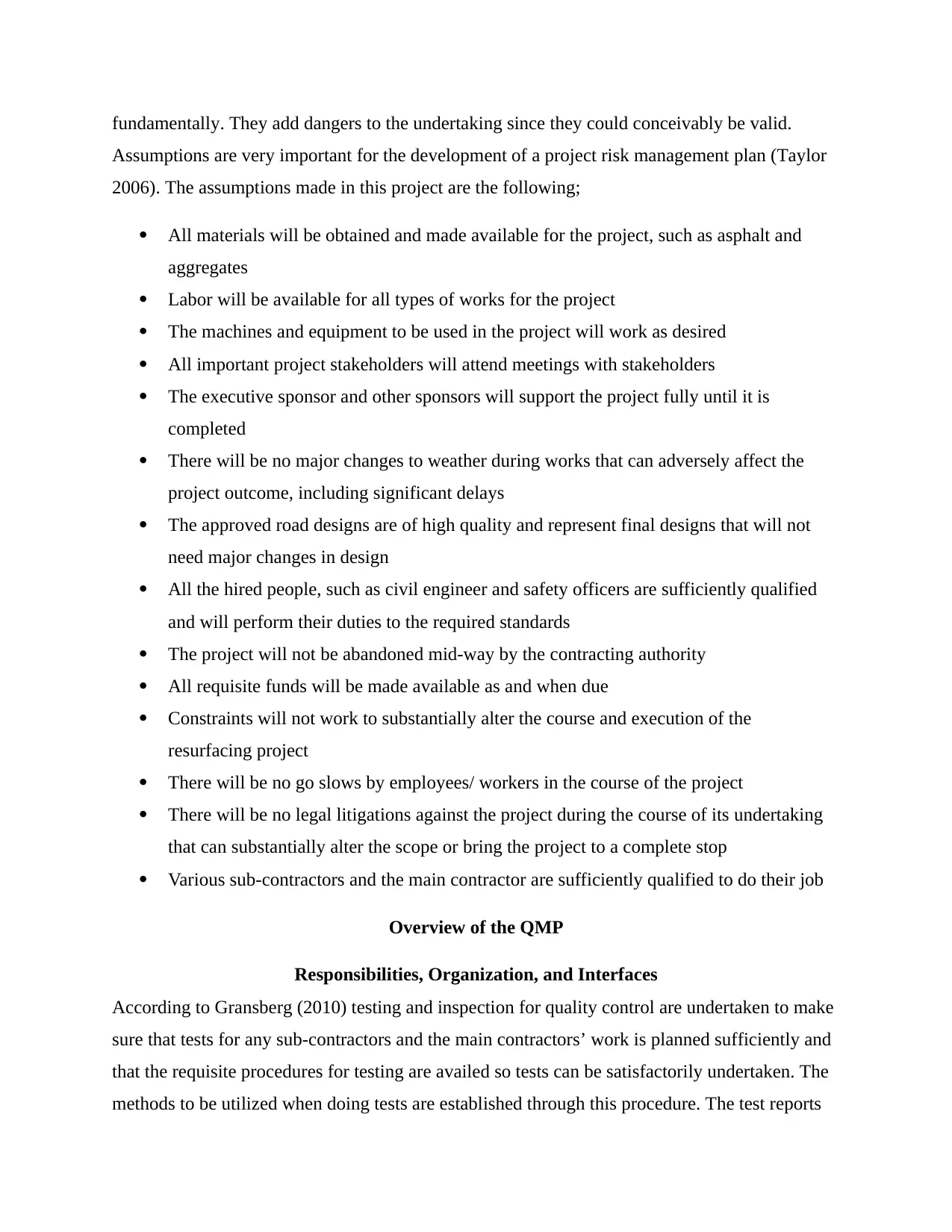
fundamentally. They add dangers to the undertaking since they could conceivably be valid.
Assumptions are very important for the development of a project risk management plan (Taylor
2006). The assumptions made in this project are the following;
All materials will be obtained and made available for the project, such as asphalt and
aggregates
Labor will be available for all types of works for the project
The machines and equipment to be used in the project will work as desired
All important project stakeholders will attend meetings with stakeholders
The executive sponsor and other sponsors will support the project fully until it is
completed
There will be no major changes to weather during works that can adversely affect the
project outcome, including significant delays
The approved road designs are of high quality and represent final designs that will not
need major changes in design
All the hired people, such as civil engineer and safety officers are sufficiently qualified
and will perform their duties to the required standards
The project will not be abandoned mid-way by the contracting authority
All requisite funds will be made available as and when due
Constraints will not work to substantially alter the course and execution of the
resurfacing project
There will be no go slows by employees/ workers in the course of the project
There will be no legal litigations against the project during the course of its undertaking
that can substantially alter the scope or bring the project to a complete stop
Various sub-contractors and the main contractor are sufficiently qualified to do their job
Overview of the QMP
Responsibilities, Organization, and Interfaces
According to Gransberg (2010) testing and inspection for quality control are undertaken to make
sure that tests for any sub-contractors and the main contractors’ work is planned sufficiently and
that the requisite procedures for testing are availed so tests can be satisfactorily undertaken. The
methods to be utilized when doing tests are established through this procedure. The test reports
Assumptions are very important for the development of a project risk management plan (Taylor
2006). The assumptions made in this project are the following;
All materials will be obtained and made available for the project, such as asphalt and
aggregates
Labor will be available for all types of works for the project
The machines and equipment to be used in the project will work as desired
All important project stakeholders will attend meetings with stakeholders
The executive sponsor and other sponsors will support the project fully until it is
completed
There will be no major changes to weather during works that can adversely affect the
project outcome, including significant delays
The approved road designs are of high quality and represent final designs that will not
need major changes in design
All the hired people, such as civil engineer and safety officers are sufficiently qualified
and will perform their duties to the required standards
The project will not be abandoned mid-way by the contracting authority
All requisite funds will be made available as and when due
Constraints will not work to substantially alter the course and execution of the
resurfacing project
There will be no go slows by employees/ workers in the course of the project
There will be no legal litigations against the project during the course of its undertaking
that can substantially alter the scope or bring the project to a complete stop
Various sub-contractors and the main contractor are sufficiently qualified to do their job
Overview of the QMP
Responsibilities, Organization, and Interfaces
According to Gransberg (2010) testing and inspection for quality control are undertaken to make
sure that tests for any sub-contractors and the main contractors’ work is planned sufficiently and
that the requisite procedures for testing are availed so tests can be satisfactorily undertaken. The
methods to be utilized when doing tests are established through this procedure. The test reports
Paraphrase This Document
Need a fresh take? Get an instant paraphrase of this document with our AI Paraphraser
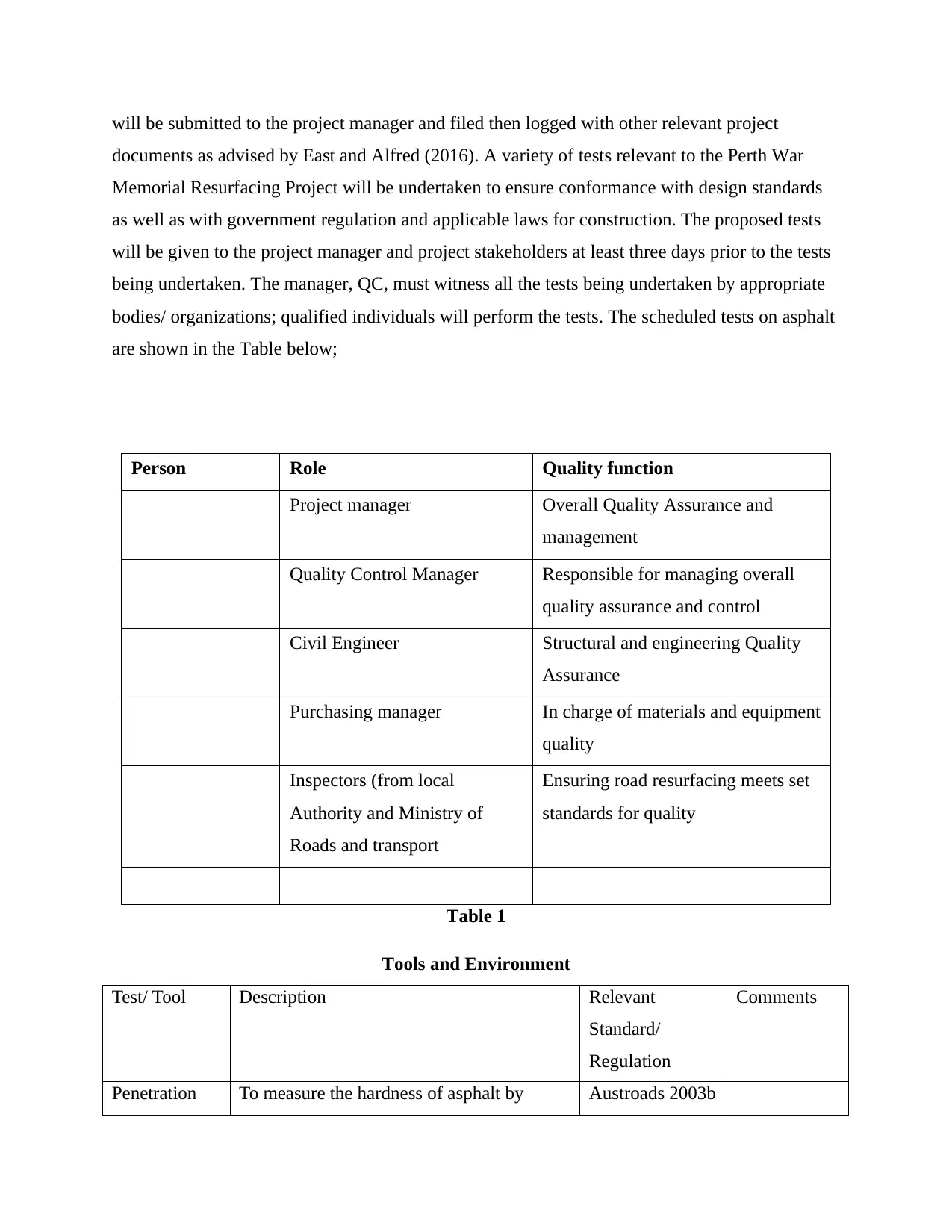
will be submitted to the project manager and filed then logged with other relevant project
documents as advised by East and Alfred (2016). A variety of tests relevant to the Perth War
Memorial Resurfacing Project will be undertaken to ensure conformance with design standards
as well as with government regulation and applicable laws for construction. The proposed tests
will be given to the project manager and project stakeholders at least three days prior to the tests
being undertaken. The manager, QC, must witness all the tests being undertaken by appropriate
bodies/ organizations; qualified individuals will perform the tests. The scheduled tests on asphalt
are shown in the Table below;
Person Role Quality function
Project manager Overall Quality Assurance and
management
Quality Control Manager Responsible for managing overall
quality assurance and control
Civil Engineer Structural and engineering Quality
Assurance
Purchasing manager In charge of materials and equipment
quality
Inspectors (from local
Authority and Ministry of
Roads and transport
Ensuring road resurfacing meets set
standards for quality
Table 1
Tools and Environment
Test/ Tool Description Relevant
Standard/
Regulation
Comments
Penetration To measure the hardness of asphalt by Austroads 2003b
documents as advised by East and Alfred (2016). A variety of tests relevant to the Perth War
Memorial Resurfacing Project will be undertaken to ensure conformance with design standards
as well as with government regulation and applicable laws for construction. The proposed tests
will be given to the project manager and project stakeholders at least three days prior to the tests
being undertaken. The manager, QC, must witness all the tests being undertaken by appropriate
bodies/ organizations; qualified individuals will perform the tests. The scheduled tests on asphalt
are shown in the Table below;
Person Role Quality function
Project manager Overall Quality Assurance and
management
Quality Control Manager Responsible for managing overall
quality assurance and control
Civil Engineer Structural and engineering Quality
Assurance
Purchasing manager In charge of materials and equipment
quality
Inspectors (from local
Authority and Ministry of
Roads and transport
Ensuring road resurfacing meets set
standards for quality
Table 1
Tools and Environment
Test/ Tool Description Relevant
Standard/
Regulation
Comments
Penetration To measure the hardness of asphalt by Austroads 2003b
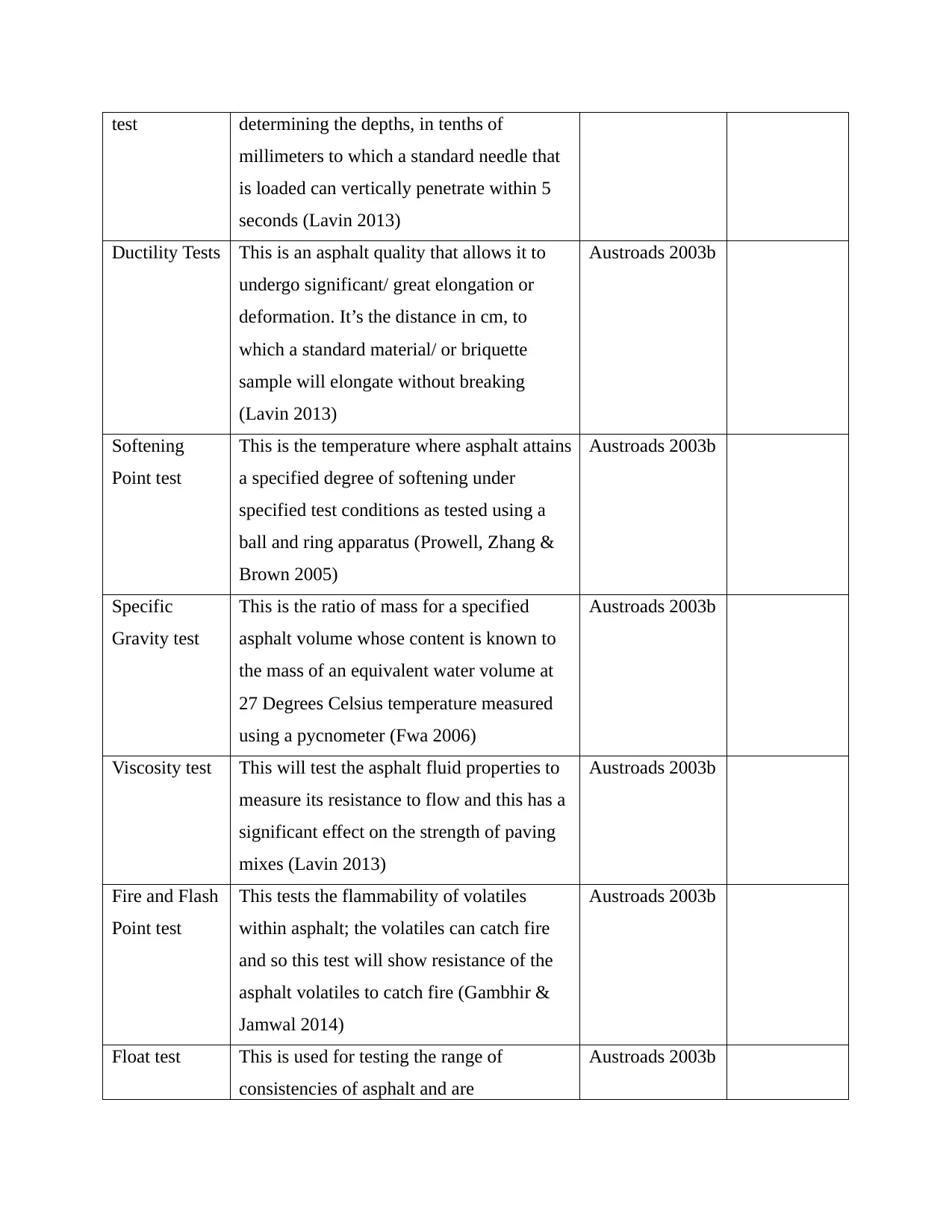
test determining the depths, in tenths of
millimeters to which a standard needle that
is loaded can vertically penetrate within 5
seconds (Lavin 2013)
Ductility Tests This is an asphalt quality that allows it to
undergo significant/ great elongation or
deformation. It’s the distance in cm, to
which a standard material/ or briquette
sample will elongate without breaking
(Lavin 2013)
Austroads 2003b
Softening
Point test
This is the temperature where asphalt attains
a specified degree of softening under
specified test conditions as tested using a
ball and ring apparatus (Prowell, Zhang &
Brown 2005)
Austroads 2003b
Specific
Gravity test
This is the ratio of mass for a specified
asphalt volume whose content is known to
the mass of an equivalent water volume at
27 Degrees Celsius temperature measured
using a pycnometer (Fwa 2006)
Austroads 2003b
Viscosity test This will test the asphalt fluid properties to
measure its resistance to flow and this has a
significant effect on the strength of paving
mixes (Lavin 2013)
Austroads 2003b
Fire and Flash
Point test
This tests the flammability of volatiles
within asphalt; the volatiles can catch fire
and so this test will show resistance of the
asphalt volatiles to catch fire (Gambhir &
Jamwal 2014)
Austroads 2003b
Float test This is used for testing the range of
consistencies of asphalt and are
Austroads 2003b
millimeters to which a standard needle that
is loaded can vertically penetrate within 5
seconds (Lavin 2013)
Ductility Tests This is an asphalt quality that allows it to
undergo significant/ great elongation or
deformation. It’s the distance in cm, to
which a standard material/ or briquette
sample will elongate without breaking
(Lavin 2013)
Austroads 2003b
Softening
Point test
This is the temperature where asphalt attains
a specified degree of softening under
specified test conditions as tested using a
ball and ring apparatus (Prowell, Zhang &
Brown 2005)
Austroads 2003b
Specific
Gravity test
This is the ratio of mass for a specified
asphalt volume whose content is known to
the mass of an equivalent water volume at
27 Degrees Celsius temperature measured
using a pycnometer (Fwa 2006)
Austroads 2003b
Viscosity test This will test the asphalt fluid properties to
measure its resistance to flow and this has a
significant effect on the strength of paving
mixes (Lavin 2013)
Austroads 2003b
Fire and Flash
Point test
This tests the flammability of volatiles
within asphalt; the volatiles can catch fire
and so this test will show resistance of the
asphalt volatiles to catch fire (Gambhir &
Jamwal 2014)
Austroads 2003b
Float test This is used for testing the range of
consistencies of asphalt and are
Austroads 2003b
⊘ This is a preview!⊘
Do you want full access?
Subscribe today to unlock all pages.

Trusted by 1+ million students worldwide
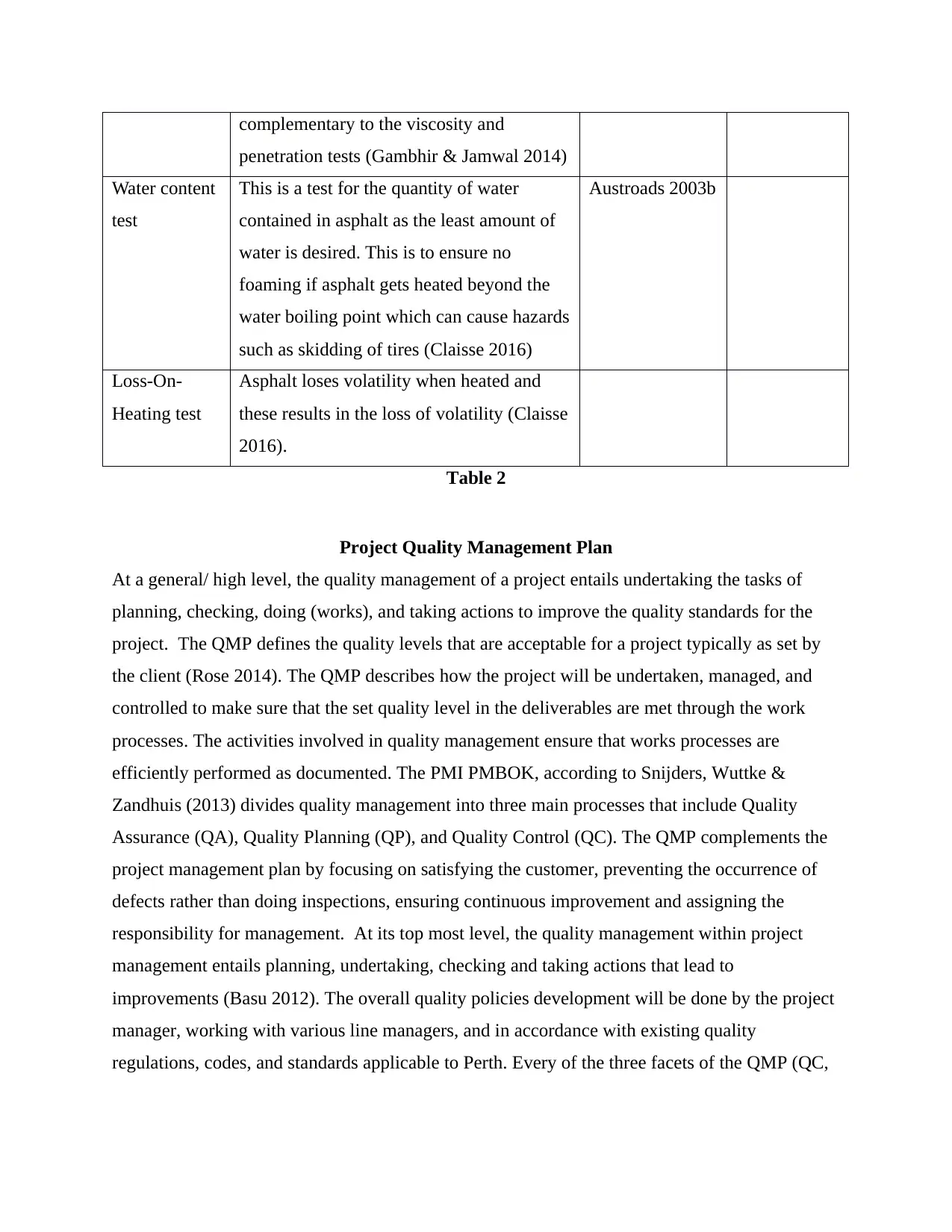
complementary to the viscosity and
penetration tests (Gambhir & Jamwal 2014)
Water content
test
This is a test for the quantity of water
contained in asphalt as the least amount of
water is desired. This is to ensure no
foaming if asphalt gets heated beyond the
water boiling point which can cause hazards
such as skidding of tires (Claisse 2016)
Austroads 2003b
Loss-On-
Heating test
Asphalt loses volatility when heated and
these results in the loss of volatility (Claisse
2016).
Table 2
Project Quality Management Plan
At a general/ high level, the quality management of a project entails undertaking the tasks of
planning, checking, doing (works), and taking actions to improve the quality standards for the
project. The QMP defines the quality levels that are acceptable for a project typically as set by
the client (Rose 2014). The QMP describes how the project will be undertaken, managed, and
controlled to make sure that the set quality level in the deliverables are met through the work
processes. The activities involved in quality management ensure that works processes are
efficiently performed as documented. The PMI PMBOK, according to Snijders, Wuttke &
Zandhuis (2013) divides quality management into three main processes that include Quality
Assurance (QA), Quality Planning (QP), and Quality Control (QC). The QMP complements the
project management plan by focusing on satisfying the customer, preventing the occurrence of
defects rather than doing inspections, ensuring continuous improvement and assigning the
responsibility for management. At its top most level, the quality management within project
management entails planning, undertaking, checking and taking actions that lead to
improvements (Basu 2012). The overall quality policies development will be done by the project
manager, working with various line managers, and in accordance with existing quality
regulations, codes, and standards applicable to Perth. Every of the three facets of the QMP (QC,
penetration tests (Gambhir & Jamwal 2014)
Water content
test
This is a test for the quantity of water
contained in asphalt as the least amount of
water is desired. This is to ensure no
foaming if asphalt gets heated beyond the
water boiling point which can cause hazards
such as skidding of tires (Claisse 2016)
Austroads 2003b
Loss-On-
Heating test
Asphalt loses volatility when heated and
these results in the loss of volatility (Claisse
2016).
Table 2
Project Quality Management Plan
At a general/ high level, the quality management of a project entails undertaking the tasks of
planning, checking, doing (works), and taking actions to improve the quality standards for the
project. The QMP defines the quality levels that are acceptable for a project typically as set by
the client (Rose 2014). The QMP describes how the project will be undertaken, managed, and
controlled to make sure that the set quality level in the deliverables are met through the work
processes. The activities involved in quality management ensure that works processes are
efficiently performed as documented. The PMI PMBOK, according to Snijders, Wuttke &
Zandhuis (2013) divides quality management into three main processes that include Quality
Assurance (QA), Quality Planning (QP), and Quality Control (QC). The QMP complements the
project management plan by focusing on satisfying the customer, preventing the occurrence of
defects rather than doing inspections, ensuring continuous improvement and assigning the
responsibility for management. At its top most level, the quality management within project
management entails planning, undertaking, checking and taking actions that lead to
improvements (Basu 2012). The overall quality policies development will be done by the project
manager, working with various line managers, and in accordance with existing quality
regulations, codes, and standards applicable to Perth. Every of the three facets of the QMP (QC,
Paraphrase This Document
Need a fresh take? Get an instant paraphrase of this document with our AI Paraphraser
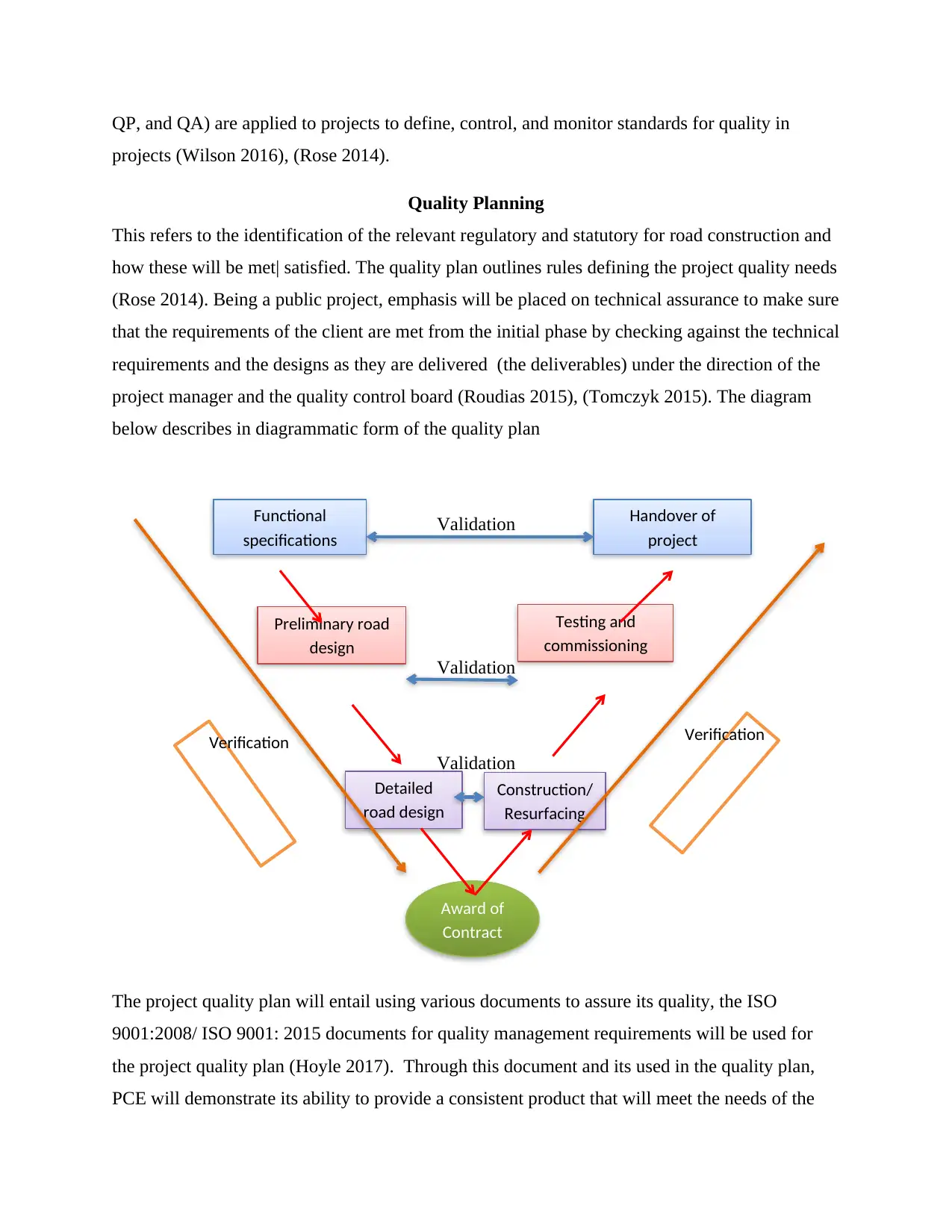
QP, and QA) are applied to projects to define, control, and monitor standards for quality in
projects (Wilson 2016), (Rose 2014).
Quality Planning
This refers to the identification of the relevant regulatory and statutory for road construction and
how these will be met| satisfied. The quality plan outlines rules defining the project quality needs
(Rose 2014). Being a public project, emphasis will be placed on technical assurance to make sure
that the requirements of the client are met from the initial phase by checking against the technical
requirements and the designs as they are delivered (the deliverables) under the direction of the
project manager and the quality control board (Roudias 2015), (Tomczyk 2015). The diagram
below describes in diagrammatic form of the quality plan
Validation
Validation
Validation
The project quality plan will entail using various documents to assure its quality, the ISO
9001:2008/ ISO 9001: 2015 documents for quality management requirements will be used for
the project quality plan (Hoyle 2017). Through this document and its used in the quality plan,
PCE will demonstrate its ability to provide a consistent product that will meet the needs of the
Functional
specifications
Handover of
project
Preliminary road
design
Testing and
commissioning
Detailed
road design
Construction/
Resurfacing
Award of
Contract
Verification Verification
projects (Wilson 2016), (Rose 2014).
Quality Planning
This refers to the identification of the relevant regulatory and statutory for road construction and
how these will be met| satisfied. The quality plan outlines rules defining the project quality needs
(Rose 2014). Being a public project, emphasis will be placed on technical assurance to make sure
that the requirements of the client are met from the initial phase by checking against the technical
requirements and the designs as they are delivered (the deliverables) under the direction of the
project manager and the quality control board (Roudias 2015), (Tomczyk 2015). The diagram
below describes in diagrammatic form of the quality plan
Validation
Validation
Validation
The project quality plan will entail using various documents to assure its quality, the ISO
9001:2008/ ISO 9001: 2015 documents for quality management requirements will be used for
the project quality plan (Hoyle 2017). Through this document and its used in the quality plan,
PCE will demonstrate its ability to provide a consistent product that will meet the needs of the
Functional
specifications
Handover of
project
Preliminary road
design
Testing and
commissioning
Detailed
road design
Construction/
Resurfacing
Award of
Contract
Verification Verification
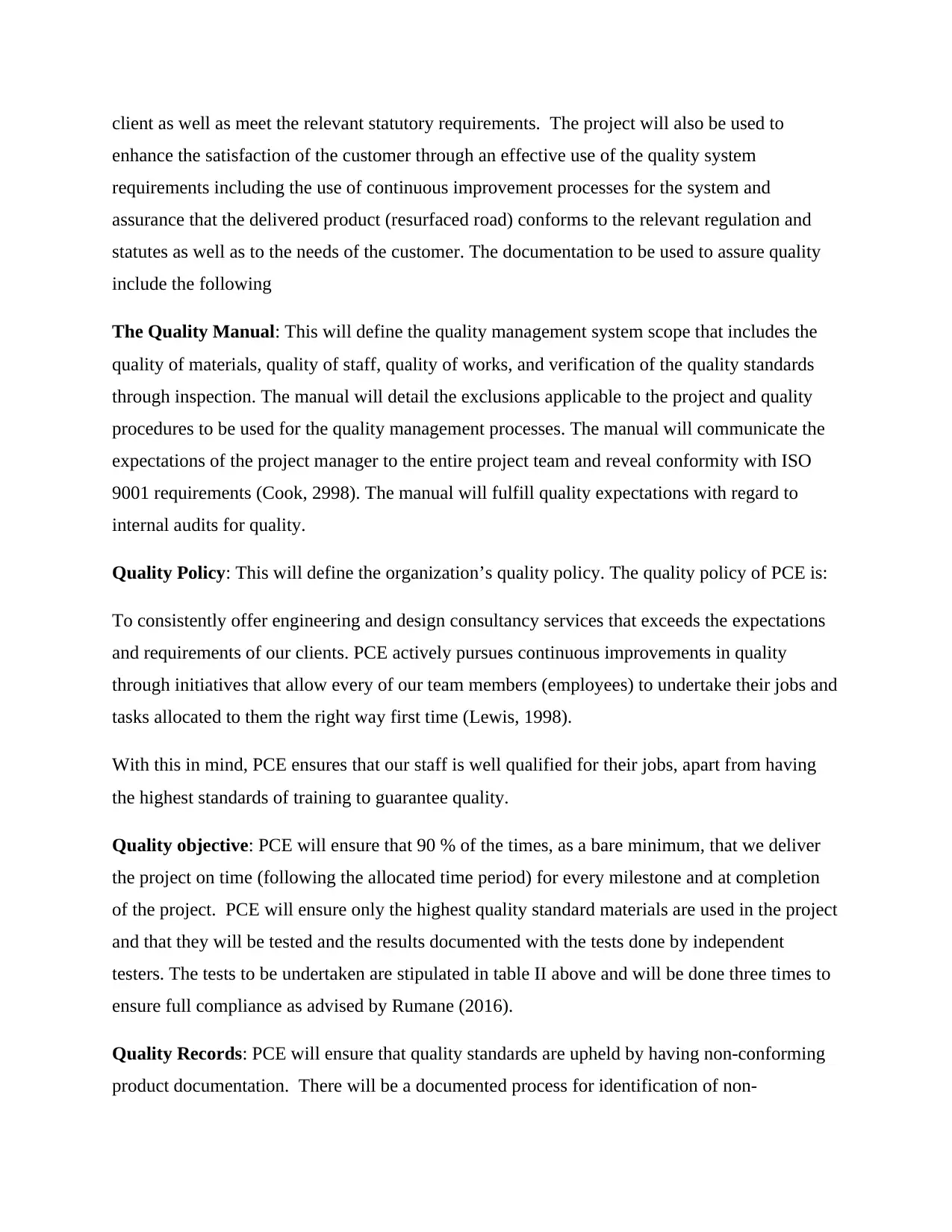
client as well as meet the relevant statutory requirements. The project will also be used to
enhance the satisfaction of the customer through an effective use of the quality system
requirements including the use of continuous improvement processes for the system and
assurance that the delivered product (resurfaced road) conforms to the relevant regulation and
statutes as well as to the needs of the customer. The documentation to be used to assure quality
include the following
The Quality Manual: This will define the quality management system scope that includes the
quality of materials, quality of staff, quality of works, and verification of the quality standards
through inspection. The manual will detail the exclusions applicable to the project and quality
procedures to be used for the quality management processes. The manual will communicate the
expectations of the project manager to the entire project team and reveal conformity with ISO
9001 requirements (Cook, 2998). The manual will fulfill quality expectations with regard to
internal audits for quality.
Quality Policy: This will define the organization’s quality policy. The quality policy of PCE is:
To consistently offer engineering and design consultancy services that exceeds the expectations
and requirements of our clients. PCE actively pursues continuous improvements in quality
through initiatives that allow every of our team members (employees) to undertake their jobs and
tasks allocated to them the right way first time (Lewis, 1998).
With this in mind, PCE ensures that our staff is well qualified for their jobs, apart from having
the highest standards of training to guarantee quality.
Quality objective: PCE will ensure that 90 % of the times, as a bare minimum, that we deliver
the project on time (following the allocated time period) for every milestone and at completion
of the project. PCE will ensure only the highest quality standard materials are used in the project
and that they will be tested and the results documented with the tests done by independent
testers. The tests to be undertaken are stipulated in table II above and will be done three times to
ensure full compliance as advised by Rumane (2016).
Quality Records: PCE will ensure that quality standards are upheld by having non-conforming
product documentation. There will be a documented process for identification of non-
enhance the satisfaction of the customer through an effective use of the quality system
requirements including the use of continuous improvement processes for the system and
assurance that the delivered product (resurfaced road) conforms to the relevant regulation and
statutes as well as to the needs of the customer. The documentation to be used to assure quality
include the following
The Quality Manual: This will define the quality management system scope that includes the
quality of materials, quality of staff, quality of works, and verification of the quality standards
through inspection. The manual will detail the exclusions applicable to the project and quality
procedures to be used for the quality management processes. The manual will communicate the
expectations of the project manager to the entire project team and reveal conformity with ISO
9001 requirements (Cook, 2998). The manual will fulfill quality expectations with regard to
internal audits for quality.
Quality Policy: This will define the organization’s quality policy. The quality policy of PCE is:
To consistently offer engineering and design consultancy services that exceeds the expectations
and requirements of our clients. PCE actively pursues continuous improvements in quality
through initiatives that allow every of our team members (employees) to undertake their jobs and
tasks allocated to them the right way first time (Lewis, 1998).
With this in mind, PCE ensures that our staff is well qualified for their jobs, apart from having
the highest standards of training to guarantee quality.
Quality objective: PCE will ensure that 90 % of the times, as a bare minimum, that we deliver
the project on time (following the allocated time period) for every milestone and at completion
of the project. PCE will ensure only the highest quality standard materials are used in the project
and that they will be tested and the results documented with the tests done by independent
testers. The tests to be undertaken are stipulated in table II above and will be done three times to
ensure full compliance as advised by Rumane (2016).
Quality Records: PCE will ensure that quality standards are upheld by having non-conforming
product documentation. There will be a documented process for identification of non-
⊘ This is a preview!⊘
Do you want full access?
Subscribe today to unlock all pages.

Trusted by 1+ million students worldwide
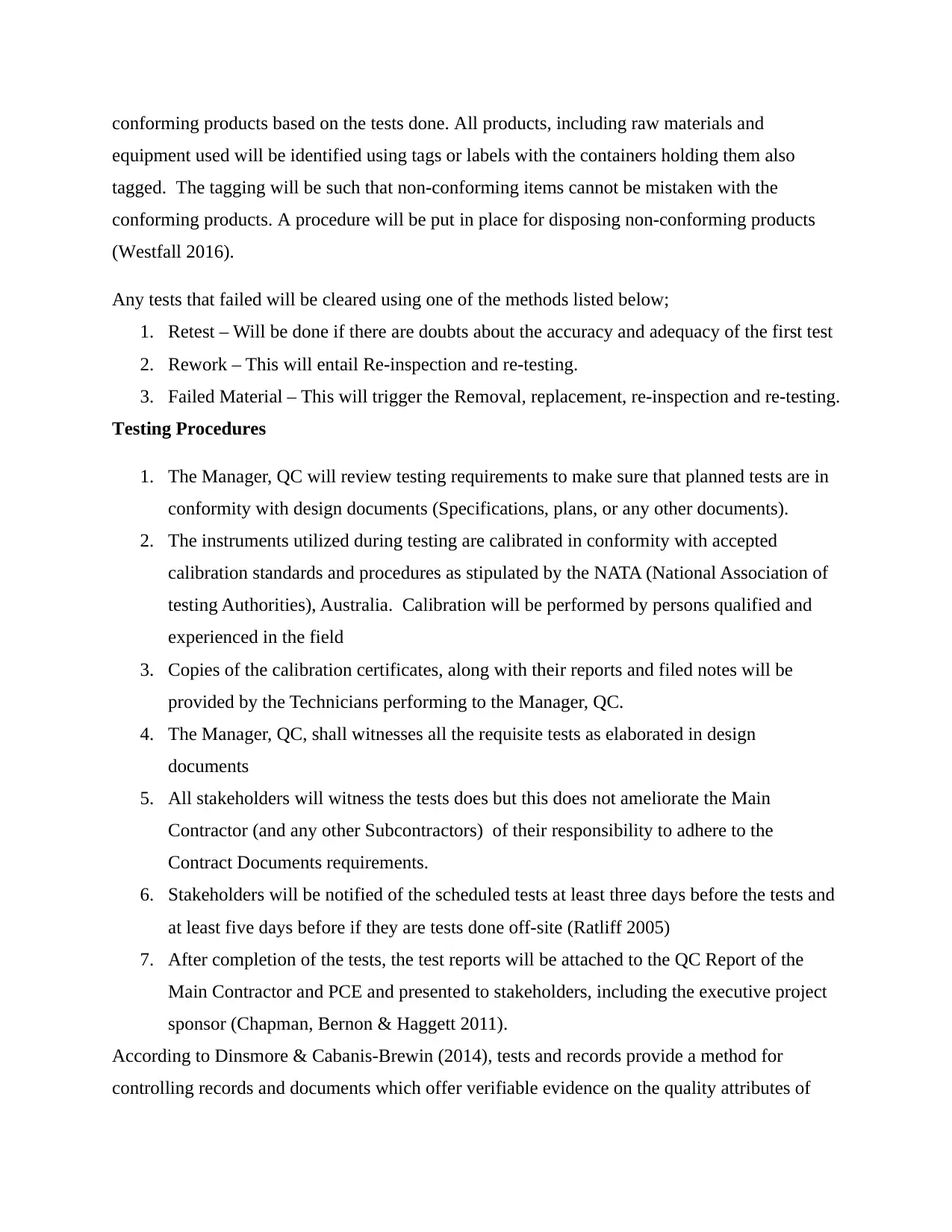
conforming products based on the tests done. All products, including raw materials and
equipment used will be identified using tags or labels with the containers holding them also
tagged. The tagging will be such that non-conforming items cannot be mistaken with the
conforming products. A procedure will be put in place for disposing non-conforming products
(Westfall 2016).
Any tests that failed will be cleared using one of the methods listed below;
1. Retest – Will be done if there are doubts about the accuracy and adequacy of the first test
2. Rework – This will entail Re-inspection and re-testing.
3. Failed Material – This will trigger the Removal, replacement, re-inspection and re-testing.
Testing Procedures
1. The Manager, QC will review testing requirements to make sure that planned tests are in
conformity with design documents (Specifications, plans, or any other documents).
2. The instruments utilized during testing are calibrated in conformity with accepted
calibration standards and procedures as stipulated by the NATA (National Association of
testing Authorities), Australia. Calibration will be performed by persons qualified and
experienced in the field
3. Copies of the calibration certificates, along with their reports and filed notes will be
provided by the Technicians performing to the Manager, QC.
4. The Manager, QC, shall witnesses all the requisite tests as elaborated in design
documents
5. All stakeholders will witness the tests does but this does not ameliorate the Main
Contractor (and any other Subcontractors) of their responsibility to adhere to the
Contract Documents requirements.
6. Stakeholders will be notified of the scheduled tests at least three days before the tests and
at least five days before if they are tests done off-site (Ratliff 2005)
7. After completion of the tests, the test reports will be attached to the QC Report of the
Main Contractor and PCE and presented to stakeholders, including the executive project
sponsor (Chapman, Bernon & Haggett 2011).
According to Dinsmore & Cabanis-Brewin (2014), tests and records provide a method for
controlling records and documents which offer verifiable evidence on the quality attributes of
equipment used will be identified using tags or labels with the containers holding them also
tagged. The tagging will be such that non-conforming items cannot be mistaken with the
conforming products. A procedure will be put in place for disposing non-conforming products
(Westfall 2016).
Any tests that failed will be cleared using one of the methods listed below;
1. Retest – Will be done if there are doubts about the accuracy and adequacy of the first test
2. Rework – This will entail Re-inspection and re-testing.
3. Failed Material – This will trigger the Removal, replacement, re-inspection and re-testing.
Testing Procedures
1. The Manager, QC will review testing requirements to make sure that planned tests are in
conformity with design documents (Specifications, plans, or any other documents).
2. The instruments utilized during testing are calibrated in conformity with accepted
calibration standards and procedures as stipulated by the NATA (National Association of
testing Authorities), Australia. Calibration will be performed by persons qualified and
experienced in the field
3. Copies of the calibration certificates, along with their reports and filed notes will be
provided by the Technicians performing to the Manager, QC.
4. The Manager, QC, shall witnesses all the requisite tests as elaborated in design
documents
5. All stakeholders will witness the tests does but this does not ameliorate the Main
Contractor (and any other Subcontractors) of their responsibility to adhere to the
Contract Documents requirements.
6. Stakeholders will be notified of the scheduled tests at least three days before the tests and
at least five days before if they are tests done off-site (Ratliff 2005)
7. After completion of the tests, the test reports will be attached to the QC Report of the
Main Contractor and PCE and presented to stakeholders, including the executive project
sponsor (Chapman, Bernon & Haggett 2011).
According to Dinsmore & Cabanis-Brewin (2014), tests and records provide a method for
controlling records and documents which offer verifiable evidence on the quality attributes of
Paraphrase This Document
Need a fresh take? Get an instant paraphrase of this document with our AI Paraphraser
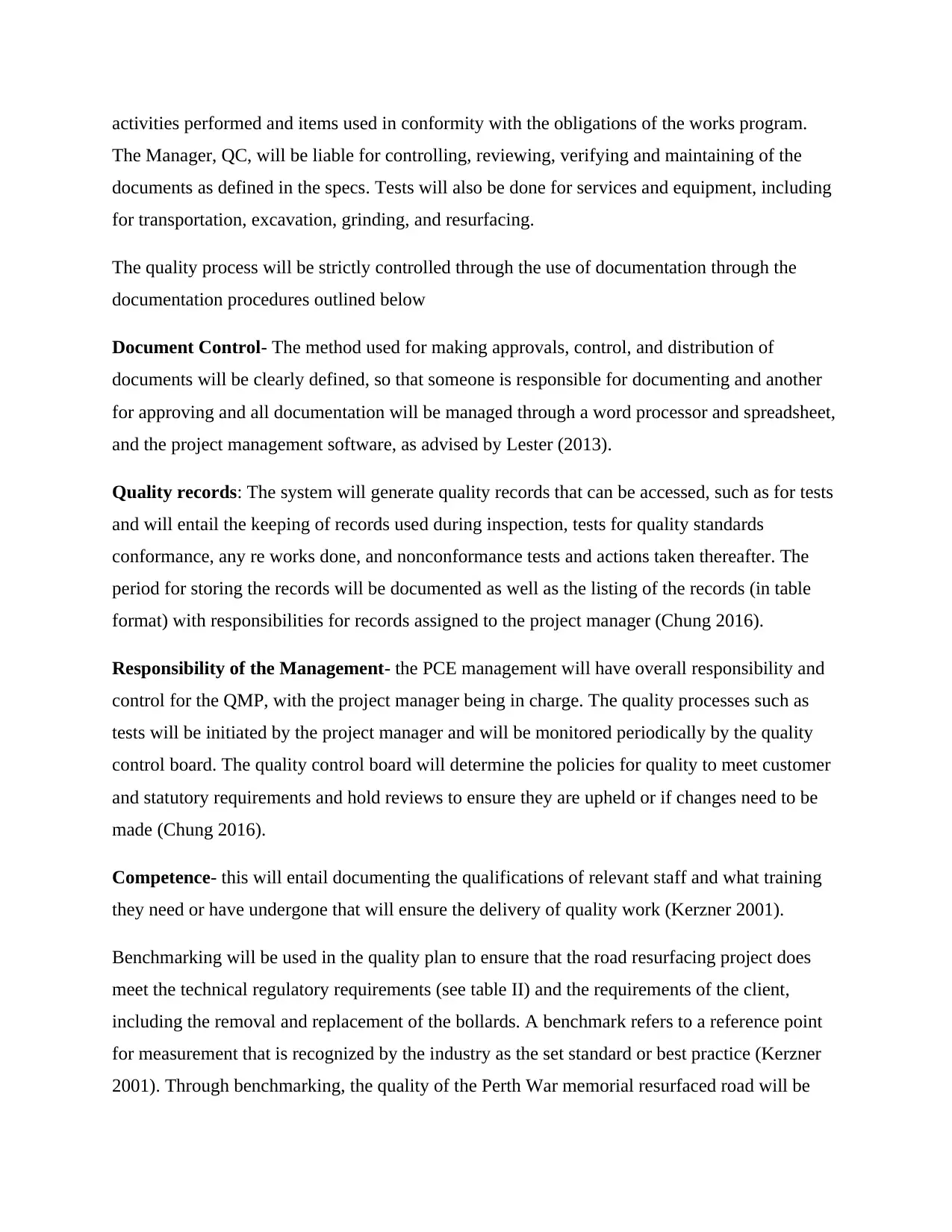
activities performed and items used in conformity with the obligations of the works program.
The Manager, QC, will be liable for controlling, reviewing, verifying and maintaining of the
documents as defined in the specs. Tests will also be done for services and equipment, including
for transportation, excavation, grinding, and resurfacing.
The quality process will be strictly controlled through the use of documentation through the
documentation procedures outlined below
Document Control- The method used for making approvals, control, and distribution of
documents will be clearly defined, so that someone is responsible for documenting and another
for approving and all documentation will be managed through a word processor and spreadsheet,
and the project management software, as advised by Lester (2013).
Quality records: The system will generate quality records that can be accessed, such as for tests
and will entail the keeping of records used during inspection, tests for quality standards
conformance, any re works done, and nonconformance tests and actions taken thereafter. The
period for storing the records will be documented as well as the listing of the records (in table
format) with responsibilities for records assigned to the project manager (Chung 2016).
Responsibility of the Management- the PCE management will have overall responsibility and
control for the QMP, with the project manager being in charge. The quality processes such as
tests will be initiated by the project manager and will be monitored periodically by the quality
control board. The quality control board will determine the policies for quality to meet customer
and statutory requirements and hold reviews to ensure they are upheld or if changes need to be
made (Chung 2016).
Competence- this will entail documenting the qualifications of relevant staff and what training
they need or have undergone that will ensure the delivery of quality work (Kerzner 2001).
Benchmarking will be used in the quality plan to ensure that the road resurfacing project does
meet the technical regulatory requirements (see table II) and the requirements of the client,
including the removal and replacement of the bollards. A benchmark refers to a reference point
for measurement that is recognized by the industry as the set standard or best practice (Kerzner
2001). Through benchmarking, the quality of the Perth War memorial resurfaced road will be
The Manager, QC, will be liable for controlling, reviewing, verifying and maintaining of the
documents as defined in the specs. Tests will also be done for services and equipment, including
for transportation, excavation, grinding, and resurfacing.
The quality process will be strictly controlled through the use of documentation through the
documentation procedures outlined below
Document Control- The method used for making approvals, control, and distribution of
documents will be clearly defined, so that someone is responsible for documenting and another
for approving and all documentation will be managed through a word processor and spreadsheet,
and the project management software, as advised by Lester (2013).
Quality records: The system will generate quality records that can be accessed, such as for tests
and will entail the keeping of records used during inspection, tests for quality standards
conformance, any re works done, and nonconformance tests and actions taken thereafter. The
period for storing the records will be documented as well as the listing of the records (in table
format) with responsibilities for records assigned to the project manager (Chung 2016).
Responsibility of the Management- the PCE management will have overall responsibility and
control for the QMP, with the project manager being in charge. The quality processes such as
tests will be initiated by the project manager and will be monitored periodically by the quality
control board. The quality control board will determine the policies for quality to meet customer
and statutory requirements and hold reviews to ensure they are upheld or if changes need to be
made (Chung 2016).
Competence- this will entail documenting the qualifications of relevant staff and what training
they need or have undergone that will ensure the delivery of quality work (Kerzner 2001).
Benchmarking will be used in the quality plan to ensure that the road resurfacing project does
meet the technical regulatory requirements (see table II) and the requirements of the client,
including the removal and replacement of the bollards. A benchmark refers to a reference point
for measurement that is recognized by the industry as the set standard or best practice (Kerzner
2001). Through benchmarking, the quality of the Perth War memorial resurfaced road will be
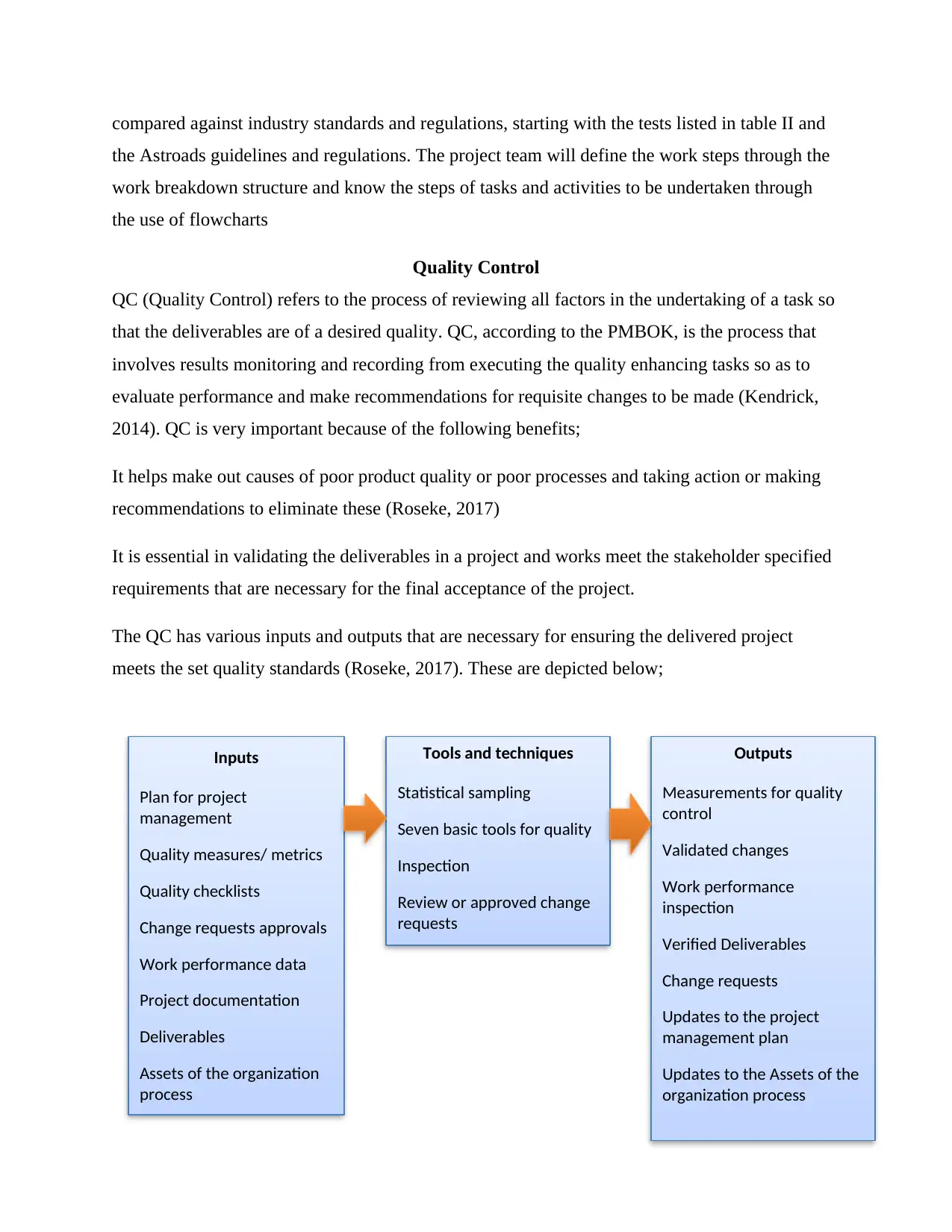
compared against industry standards and regulations, starting with the tests listed in table II and
the Astroads guidelines and regulations. The project team will define the work steps through the
work breakdown structure and know the steps of tasks and activities to be undertaken through
the use of flowcharts
Quality Control
QC (Quality Control) refers to the process of reviewing all factors in the undertaking of a task so
that the deliverables are of a desired quality. QC, according to the PMBOK, is the process that
involves results monitoring and recording from executing the quality enhancing tasks so as to
evaluate performance and make recommendations for requisite changes to be made (Kendrick,
2014). QC is very important because of the following benefits;
It helps make out causes of poor product quality or poor processes and taking action or making
recommendations to eliminate these (Roseke, 2017)
It is essential in validating the deliverables in a project and works meet the stakeholder specified
requirements that are necessary for the final acceptance of the project.
The QC has various inputs and outputs that are necessary for ensuring the delivered project
meets the set quality standards (Roseke, 2017). These are depicted below;
Inputs
Plan for project
management
Quality measures/ metrics
Quality checklists
Change requests approvals
Work performance data
Project documentation
Deliverables
Assets of the organization
process
Tools and techniques
Statistical sampling
Seven basic tools for quality
Inspection
Review or approved change
requests
Outputs
Measurements for quality
control
Validated changes
Work performance
inspection
Verified Deliverables
Change requests
Updates to the project
management plan
Updates to the Assets of the
organization process
the Astroads guidelines and regulations. The project team will define the work steps through the
work breakdown structure and know the steps of tasks and activities to be undertaken through
the use of flowcharts
Quality Control
QC (Quality Control) refers to the process of reviewing all factors in the undertaking of a task so
that the deliverables are of a desired quality. QC, according to the PMBOK, is the process that
involves results monitoring and recording from executing the quality enhancing tasks so as to
evaluate performance and make recommendations for requisite changes to be made (Kendrick,
2014). QC is very important because of the following benefits;
It helps make out causes of poor product quality or poor processes and taking action or making
recommendations to eliminate these (Roseke, 2017)
It is essential in validating the deliverables in a project and works meet the stakeholder specified
requirements that are necessary for the final acceptance of the project.
The QC has various inputs and outputs that are necessary for ensuring the delivered project
meets the set quality standards (Roseke, 2017). These are depicted below;
Inputs
Plan for project
management
Quality measures/ metrics
Quality checklists
Change requests approvals
Work performance data
Project documentation
Deliverables
Assets of the organization
process
Tools and techniques
Statistical sampling
Seven basic tools for quality
Inspection
Review or approved change
requests
Outputs
Measurements for quality
control
Validated changes
Work performance
inspection
Verified Deliverables
Change requests
Updates to the project
management plan
Updates to the Assets of the
organization process
⊘ This is a preview!⊘
Do you want full access?
Subscribe today to unlock all pages.

Trusted by 1+ million students worldwide
1 out of 21
Related Documents
Your All-in-One AI-Powered Toolkit for Academic Success.
+13062052269
info@desklib.com
Available 24*7 on WhatsApp / Email
![[object Object]](/_next/static/media/star-bottom.7253800d.svg)
Unlock your academic potential
Copyright © 2020–2025 A2Z Services. All Rights Reserved. Developed and managed by ZUCOL.




